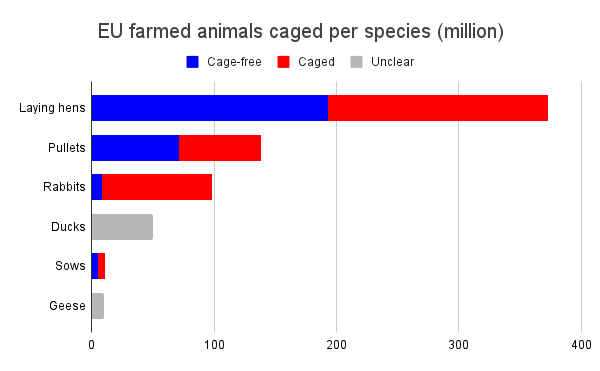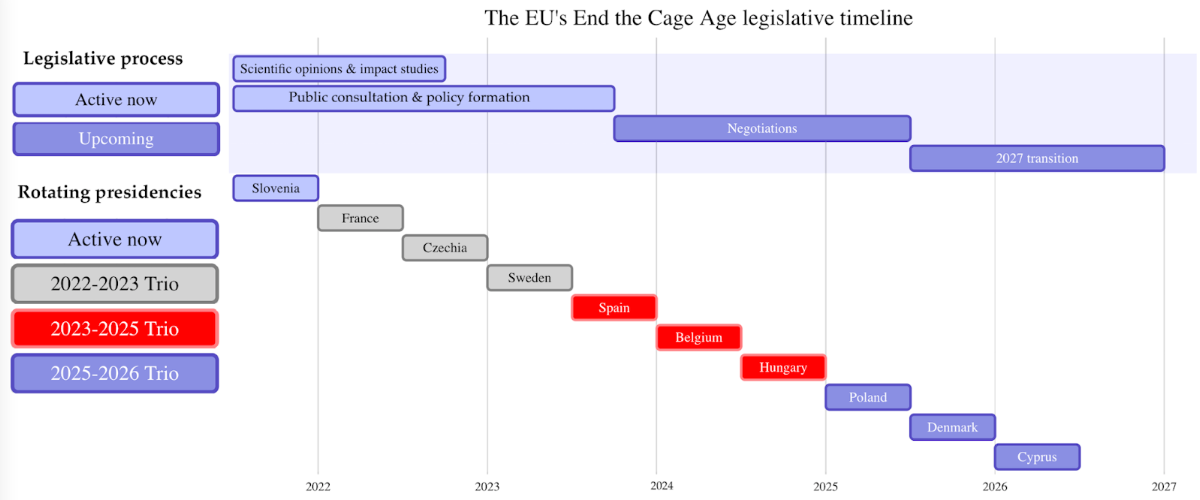This post originally appeared in the monthly farm animal welfare newsletter written by Lewis Bollard, our program officer for farm animal welfare. Sign up here to receive an email each month with Lewis’ research and insights into farm animal advocacy. Note that the newsletter is not thoroughly vetted by other staff and does not necessarily represent consensus views of Open Philanthropy as a whole.
The European Commission has promised the biggest animal welfare legal reform in history — a ban on almost all cages and crates across the European Union (EU). If enacted, the ban would cover more than 340M caged hens, rabbits, pigs, and other animals. It could also set a new global standard for farm animal welfare.
A major fight now looms. This Monday, several EU governments told the Commission that its proposal was too ambitious, and requested extensions and loopholes. Europe’s powerful farm lobby, Copa and Cogeca, is already lobbying to weaken the measure.
This presents advocates with a unique opportunity: over the next five years the EU will decide the fate of cages in Europe — and perhaps beyond. So what’s being considered, why is it happening, and how can advocates ensure it succeeds?
The Proposal — And What Comes Next
A few weeks ago, the Commission said it will propose new legislation by the end of 2023 to ban cages for the six most commonly caged species of farm animals in Europe. This is a big deal: the EU hasn’t enacted new farm animal welfare laws in over a decade, and only the Commission can propose such legislation. The Commission will spend the next two years deciding on the details, like when to ban cages by, what to replace them with, and how to enforce the ban.
The core proposal, though, is clear: the Commission committed to “phase out and finally prohibit the use of such cage systems” across the EU. The primary beneficiaries of this proposal will be hens: 180M of them are currently caged, plus another ~65M or so pullets (young hens). It will also benefit Europe’s ~90M caged rabbits, ~5M crated sows, and more ducks, geese, and other birds (see graph below).
In 2023, the Commission’s legislation will go to the two other key EU bodies: the European Parliament and Council. Both need to approve it, and can amend (read: weaken) it. The Parliament is looking good: at the end of May, it voted 558 to 37 for a resolution endorsing “phasing out the use of cages in EU animal farming.”
The Council will be trickier: EU member states have traditionally weakened or delayed most animal welfare and environmental legislation. Sure enough, at the Council’s meeting this Monday, several EU members called for a more “realistic” timeline for implementing the ban than the Commission’s ambitious suggestion of 2027. Still, only one (Bulgaria) outright opposed the ban, while many supported it, and even traditional animal welfare skeptic Poland conceded it “is something desirable.”

Causes of Victory
So how did we get to this point, where an EU-wide cage ban is finally in sight?
Both the European Commission and Parliament’s actions were direct responses to the End the Cage Age European Citizens Initiative. Compassion in World Farming launched that Initiative in 2018, at a time when the EU hadn’t proposed new legislation for farm animals in over a decade. (Disclosure: we partly funded the Initiative, but it wasn’t our idea, and we were skeptical it would succeed.) Over 170 groups across Europe collected 1.4M signatures to make it the sixth such initiative in EU history to collect the signatures needed to secure an official EU response.
CIWF and Eurogroup for Animals then worked with the Parliament and Commission to ensure the response was a good one. They were aided by the personal support of European Commissioners Stella Kyriakides and Janusz Wojciechowski, who oversee animal welfare and agriculture respectively. Indeed, Commissioner Wojciechowski’s Twitter feed sometimes reads like an animal advocate’s — last month he reminded industrial farmers that “animals are not machines.”
I think three broader forces also helped. First, legislative progress achieved by advocates in European nations. The Commission noted that “the request to phase out cages is in line with current developments, as several Member States have already implemented total or partial bans on cages.” In particular, the Commission was likely influenced by new partial cage bans in EU powerhouses Germany, France, and the Netherlands, and newer EU members like Czechia and Slovakia. Those were the result of years of sustained campaigning and litigation by advocates.
Second, corporate pledges to go cage-free. Advocates have won 1,360 such pledges in Europe, with the result that in 2019 the majority of European hens were cage-free for the first time. That made an ultimate end to at least hen cages seem inevitable, and reduced industry opposition. Indeed, just weeks before the Commission’s action, all four of the biggest German retailers pledged to stop selling the lowest-welfare meat over the next decade.
Third, the inclusion of animal welfare in sustainability discussions in Europe. The Commission cited the European Green Deal in its communication, noting “animal welfare plays a prominent role in the sustainability agenda….” This isn’t self-evident: the US Green New Deal embraced by Democrats ignored animal welfare, as do President Biden’s environmental plans. Instead, it’s a testament to how European advocates have kept animals in the sustainability discussion.

Commissioning a Cage Ban
So what can advocates do now to ensure the EU enacts the strongest possible cage ban?
The immediate priority is to get the Commission to propose the strongest possible legislation. The Commission is most likely to be swayed by scientific evidence showing the need for strong standards, economic analysis showing a quick timeline is feasible, and public input showing popular support. (The Commission just opened its public consultation, which I encourage European NGOs, scientists, and citizens to weigh in on.)
A special priority is to ensure the Commission’s legislation covers imports, so the EU’s caged production doesn’t just cross its borders. This will be a tough fight: most current EU animal welfare laws don’t cover imports, for fear of upsetting low-welfare trading partners, like the US, or the World Trade Organization (WTO). And the Commission’s proposal was non-committal: it said it would “assess the scope” for “some EU rules on imports,” but also floated toothless alternatives like labeling and “enhanced cooperation with trading partners.”
Thankfully, advocates have an unlikely ally in farmers, who want protections from low-welfare imports. Likely as a result, both the European Parliament and EU member states are pushing the Commission to include imports in their ban. Advocates should support them. We can draw on three helpful precedents: the EU’s ban on seal fur imports, which was upheld by the WTO; EU slaughter regulations, which already apply to imports; and the new EU-Mercosur trade deal, which gives preferential access to eggs that meet EU animal welfare standards.

Securing the States
Advocates’ other major priority is to line up the support of key EU member states. These states not only need to approve the Commission’s cage ban proposal (as does the Parliament); they’re also the greatest threat to weakening and delaying it. Rethink Priorities’ Neil Dullaghan’s research finds that most Commission proposals get watered down, mostly by member states. I recommend reading his strategic advice on how best to avoid that here.
Two priorities stand out. The first is to secure the support of the EU member states holding the rotating presidency of the EU Council (see graphic above). Advocates are lucky: the next trio of states holding the presidency — France, Czechia, and Sweden — all support the EU’s cage ban. The next four are more uncertain; Hungary voiced skepticism about the ban on Monday. Still there are promising signs: in recent weeks, Belgium and Poland backed a call for an EU fur farming ban, and Spain backed a call for an EU ban on killing day-old chicks.
Poland and Spain are doubly important, since they’re also critical to the second priority: securing the support of 15 EU member states accounting for 65% of the EU’s population. Advocates are likely to get enough states: there are plenty of supportive small ones like Cyprus, Luxembourg, and Malta (home to the world’s only Minister for Animal Rights). But the population threshold will be tougher. Advocates need the support of at least three of the EU’s five biggest states — France, Germany, Italy, Poland, Spain — to ensure the ban isn’t diluted. On Monday, these states mostly supported the ban or stayed silent, though they also raised concerns about the precise details. Advocates should focus on shoring up their support for a strong ban.
If you’re interested in helping, I recommend volunteering or donating to CIWF, Eurogroup, or one of the many other European groups working on this ban. (If you’re a major funder, Farmed Animal Funders is launching a new re-granting fund to support this work, advised by Neil — you can email him for more details at <[email protected]>.) And, if you’ve already helped, thank you for helping bring about this exciting milestone in ending cages!

